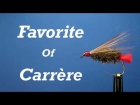Book review: Advanced Fly Tying
The Proven Methods and Techniques of a Master
AK Best has long been one of my "hero" fly tyers. If you ask me, the man has written nothing but "advanced" fly tying subjects since he first started putting his thoughts down on paper. He takes the mundane and examines every detail from every angle. Whether the shade of dubbing or quill, the size of a pair of wings, or the shape of a hook, he's got an opinion that is based on thousands of flies and years of fishing them, and he's not the least bit shy about expressing it.
After three books, hundreds of magazine articles, videos, and demonstrations all over the world, you might wonder what there is left to say? I did. I was quite curious what he would consider "advanced" fly tying.
A quick glance at the table of contents gives us a clue.
1. Vise and Tool Care
2. Using Rotary Vises
3. Saving Time
4. Hand Position
5. Necks or Saddles?
6. Hackle Sizing
7. Avoid Cone-Shaped Hackle Collars
8. Heads
9. Tying Yourself Out of Trouble
10. Delicate Flies for Skinny Water
11. Spinning Deer Hair on Small Hooks
12. Quill-Bodied Sulphurs
13. Olive Quill Dun II and Red Quill Dun II
14. Indestructible Biots
15. Flavilineas
16. Lime Trude
17. Sparke Wing Caddis
18. Clumsy Caddis
19. Large Caddis
20. Butt Faced Lemmings
21. Field Dressing Flies and the Fly-Tying Travel Kit
That's a lot of chapters and quite a variety of subjects.
If you think this book is a natural extension of Production Fly Tying and AK's Fly Box, you are on the right track. As John Gierach notes in the introduction, AK is a detail kind of guy, and if you have his set of books, there are very few details left unexamined. I mean - his discussion on how to care and feed your fly tying vise almost four pages long! Really. Not to mention an entire chapter devoted to "hand position" as it relates to tying in various materials. AK offers us a major brain dump and we will be well served to pay attention.
I found the discussion on necks vs saddles very interesting. When his first book was written, there really wasn't a choice between necks and saddles as far as dry flies were concerned. At least not for the average tyer who was scrounging for materials at his local shop or using the same few mail order catalogs. Today, the fly tyer has the choice between good hackle, great hackle, and "Oh my!" hackle, both necks and saddles, and many tyers, beginner and experienced, are wondering which is the best product for their tying and their budget. Given his fame as a tyer with more than a few notches on his bobbin, you might guess what his answer is, but you'll have to read it for yourself. I'm not going to give it away.
The chapter on hackling was excellent, although I could have used a couple more photos to better illustrate his procedures. The idea of a "cone shaped" hackle that will force a fly onto it's face will be very helpful to tyers of traditionally hackled dry flies, as will his thoughts on wrapping hackle to prevent this undesired characteristic. I've read a bunch of fly tying books and I can't ever remember this topic being discussed in any of them. Good for you, AK.
In "Tying Yourself Out of Trouble", AK gives us a few clues on how to save a fly that is partially tied should something go awry. A broken thread, a lumpy body, a crowded head, a stray fiber, etc. etc. AK takes us through a few of his favorite pet peeves and gives us a couple ideas to tie ourselves out of these situations should they arise during our own tying. If I have a complaint about this section its that a few of these problems are avoidable by sound tying procedures. Someone reading an "Advanced Fly Tying" book should be able to subconsciously leave proper space for the head of a fly or should be able to dub a smooth body. Some problems happen to us, some we cause ourselves. AK might have spent more time telling the advanced tyer not how to get out of "beginner" problems, but how to prevent them in the first place.
I was surprised to find chapters devoted to fly patterns. The title would leave me to believe this was a techniques book, but I wasn't about to complain. I've yet to meet a fly tyer who isn't a certified pattern junky, and I'm as bad as the next guy. Although I might take issue with a "Lime Trude" being considered part of an "advanced" set of flies, I can say those chapters filled the book out nicely for me. The multi-colored quill bodied flies were great, as was the chapter on flies for thin water - a topic that's becoming more important to me with every passing season.
Like I said earlier, there are a lot of chapters on a lot of different subjects. As such, don't expect to sit down and read the book from front to back like a novel. The chapters pretty much stand by themselves and don't rely on what came before or prepare you for what is coming next. There is no central theme, other than AK talking to us about fly tying. Do we really need more than that? I don't think so.
If we leave the discussion of content for a minute and just look at the book itself, we'll find a book that is every bit up to the high standards of other Lyons Press fly fishing and fly tying books. The photographs are crisp and bright with excellent color, the layout of the pages is pleasing to the eye, and the paper stock is heavy with a slight sheen. It's a quality book - as you might expect. A fine addition to your shelves, to be sure.
You might think I like this book. You'd be right. While I might have a complaint here or there, the vast quantity of raw information far outweighs them. It's not even close. There is some how-to, but better still a lot of why-to. AK passes along information as opinion, not fact, and leaves it to the reader to either agree or not. What's really cool is that even if you disagree with him, he forces you to think about why you disagree with him and you end up learning something anyway. You can't really ask for more than that.
I'm a "why" guy, and if you are too, this book is for you.
Read more about why you should register.
More content from the front page
Since you got this far …
… I have a small favor to ask.
Long story short
Support the Global FlyFisher through several different channels, including PayPal.
Long story longer
The Global FlyFisher has been online since the mid-90's and has been free to access for everybody since day one – and will stay free for as long as I run it.
But that doesn't mean that it's free to run.
It costs money to drive a large site like this.
See more details about what you can do to help in this blog post.



















































